![]() January-February 2001
January-February 2001
By Suzanne Wilson
Illustrations by Lynn Pauley
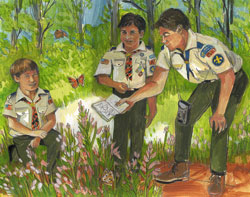 Include an illustrated field guide in your nature hike gear, to help you identify moths and butterflies and learn more about insect behavior. |
Great spangled fritillary! You'd think poets, not scientists, were in charge of naming butterflies and moths. Hummingbird hawkmoth, scalloped owlet, ruddy dagger wing, painted lady—there's even a butterfly called a question mark (because of a small silver mark on its wing).
And speaking of question marks, it's satisfying to be able to answer the many questions kids ask about these amazing insects. But first, let them tell you what they know. Budding young naturalists may already know a lot—especially if they read carefully pages 377 to 379 in the Webelos Scout Book, which contain answers to some basic questions.
You've probably had moments when you've asked yourself the same questions. Perhaps on a summer night you nearly put your hand on the widespread green wings of something resting on a screen door. You jumped back, startled.
That's what I did, anyway—and immediately wondered: butterfly or moth?
And a safe answer is always: Lepidoptera. That's because both butterflies and moths belong to the insect order Lepidoptera (lep-a-DOP-ter-a), which means scaly wings, from the Greek lepis (scale) and pteron (wing).
Read on, to learn how to tell the difference between the two and to learn other facts about these colorful, common insects. And remember, with approximately 200,000 known species of Lepidoptera (only 10 percent of which are butterflies), there is almost always an exception or two to every rule or generalization.
How do you tell the difference? Look for these clues:
There are exceptions to each "rule," but combining several observations will solve most moth-butterfly mysteries. (The green creature I almost touched was a luna or moon moth, a fantastic night flier with tails on its wings and plumed antennae.)
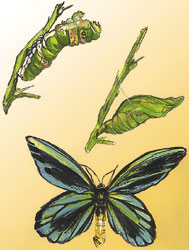 (Top) A caterpillar's appearance can change many times as it grows. (Middle) Color hides a chrysalis from predators. (Bottom) Queen Alexandra's birdwing is largest butterfly. |
What is the life cycle of a butterfly or moth? All Lepidoptera go through a four-stage life cycle or metamorphosis: egg, larva, pupa (PYOO-puh), and adult.
The larva, also called a caterpillar, sheds its skin several times as it eats plant material and grows. Then it becomes a dormant pupa with a firm outer case. Chemical changes break down the larva, and special cells form the winged adult butterfly or moth. This takes a few days to a few months, depending on the species. Adults emerge and mate, females deposit eggs on plants, and the cycle begins again.
What is a cocoon? Do both butterflies and moths make them? Moths, with some exceptions, make cocoons. A moth larva spins silk from modified salivary glands, forming a cocoon around itself. Inside, the larva changes into a pupa. A moth may incorporate a leaf or twigs in creating a cocoon.
Most butterflies have a naked pupa, no fuzz around it, so it isn't a cocoon. It's called a chrysalis (KRIS-a-liss). The chrysalis of each butterfly species has a particular shape and coloration. Some look like twigs or dead leaves, some like jeweled ornaments. The monarch's chrysalis is an elegant pale green, dotted with gold.
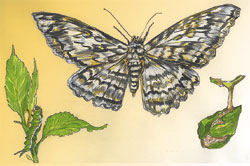 (Left) A caterpillar eats plant material. (Right) Moth cocoons may incorporate a leaf or twigs. (Middle) Giant Agrippa moth has largest wingspan. |
What are their wings made of? Butterfly and moth wings are made of thin layers of transparent chitin (KITE-n). Chitin is the same hardened protein material that forms the outside of their bodies—their exoskeletons. (Insects don't have internal skeletons.) The wings are flexible. A system of veins gives them strength, and muscles in the thorax move them.
The wings are covered with thousands of modified hairs, called scales, so tiny they seem like dust. Under a microscope, the colored scales resemble rows of overlapping shingles. Some scales have structures that break up light waves, producing metallic colors. Wing pattern and color may attract a mate, scare off a predator, or serve as camouflage.
How do you find butterflies and moths? Look for butterflies in patches of wildflowers or gardens on a sunny day. A pocket field guide will help you identify species. Some states publish their own guides.
You'll find night-flying moths near porch lights and outdoor lanterns. To attract them, hang a white sheet outside with a bright light shining on it.
Other possibilities: Find out if there's an outdoor public butterfly garden in your area. Glass-enclosed butterfly conservatories operate year round, housing native and nonnative species. Botanical gardens and zoos may have butterfly centers. Ask about admission prices for Scout groups.
Where do they go in winter? Depending on the species, Lepidoptera may spend the winter as eggs, larvae, pupae, or adults. The viceroy butterfly larva rolls up in a willow, poplar, or aspen leaf (its food plants), anchoring the leaf with silk so it doesn't fall from the tree. Mourning cloak and tortoiseshell butterflies from the last summer brood hibernate under loose bark and fly out in early spring.
Butterflies that can't survive cold temperatures at any stage fly south to continue their life cycles. The monarch is a special case; it migrates but doesn't reproduce until it returns in spring.
How many are there? Scientists estimate there may be 20,000 butterfly species and 180,000 moth species worldwide. In the United States and Canada, more than 750 butterfly species and 11,000 moth species have been identified. Discovery is ongoing.
How large, how small? Queen Alexandra's birdwing, a butterfly in New Guinea, has a wingspan of up to 11 inches, and the giant Agrippa moth of Central and South America reaches 12 inches. Some tiny nepticulid moths measure a tenth of an inch across.
There's so much to learn. And once you've become thoroughly knowledgeable about butterflies and moths, nature has many more confusing duos to learn about.
Honestly, now: Can you explain the difference between a frog and a toad, dolphin and porpoise, alligator and crocodile, hare and rabbit, tortoise and turtle?
Who said nature study couldn't be fun?
Scouting magazine contributing editor Suzanne Wilson lives in Joplin, Mo.
Read, Notice, and Know ...Butterflies and moths are insects, so their bodies consist of three parts—head, thorax, and abdomen. 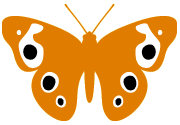
They have six legs and four wings, all attached to the thorax. In some butterflies, the two front legs are small and held close to the body, so they appear to have only four legs. They suck liquids through a proboscis (tube) that is coiled when not in use. Adults feed mainly on flower nectar, but some like fruit or obtain moisture from puddles, wet ground, or animal dung. Some moths lack a proboscis and don't eat, surviving on stored energy from the larva's meals. They live long enough to mate and deposit eggs. Antennae are scent sensors and also help with balance in flying. Feet have taste sensors. Large compound eyes, with thousands of facets each producing an image, provide 360-degree vision. Spiracles, small openings in the thorax and abdomen, let air into the respiratory system. The vast majority of Lepidoptera lack means of detecting sound, but certain groups of moths have membranes on their bodies sensitive to ultrasonic squeaks of bats that prey on the moths. Here are some helpful field guides for research and observation:
|
Creating a Butterfly Garden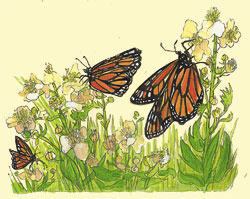
A flower garden designed to attract butterflies is fun to grow at home, and it's also a community service idea for a park, school, or retirement home. Ask for help from people who know about Lepidoptera and gardening and make sure the garden will have continuing care.
Watch for eggs and larvae on host plants. Joanna Rivera, who writes a kids' page for Butterfly Garden News, a quarterly newsletter published by the North American Butterfly Association (NABA), suggests tenting a plant with netting and tying it around the bottom, so the larvae won't wander away. Check a tented plant frequently. If the larvae consume nearly all the leaves, remove the netting so they can travel to another plant. Watch as the chrysalis forms and release the butterfly when it emerges. "This gives kids a connection between plants and butterflies," Rivera says, and that helps them understand the need to preserve the insects' habitat. For $3 each, regional butterfly gardening brochures are available from NABA, Butterfly Gardens and Habitats, 909 Birch St., Baraboo, WI 53913. They also may be downloaded as PDF files from the NABA Internet site, http://www.naba.org. A Millennium Butterfly Garden Kit with 25 seed packets of both annual and perennial nectar plants and an instruction booklet is available for $25 from Monarch Watch, c/o Orley Taylor, Department of Entomology, University of Kansas, Lawrence, KS 66045. (Or go online and print an order form at http://www.monarchwatch.org.) For more information, call toll free, (888) TAGGING, or FAX (785) 864-4441. |
Copyright © 2001 by the Boy Scouts of America. All rights thereunder reserved; anything appearing in Scouting magazine or on its Web site may not be reprinted either wholly or in part without written permission. Because of freedom given authors, opinions may not reflect official concurrence.
| The Boy Scouts of America | http://www.scouting.org |